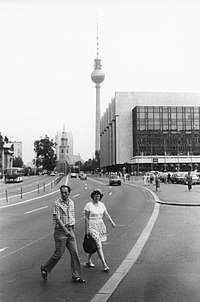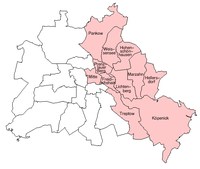East Berlin
 |
 |
 |
 |
East Berlin was the name given to the eastern part of Berlin between 1949 and 1990. It consisted of the Soviet sector of Berlin that was established in 1945. The American, British and French sectors became West Berlin, a de facto part of West Germany.
Despite its status as part of an occupied city, East Berlin was the capital of East Germany. From August 13, 1961 until November 9, 1989 it was separated from West Berlin by the Berlin Wall. The official East German lexicon referred to East Berlin as just "Berlin" or often "Berlin, Hauptstadt der DDR" (Berlin, capital of the GDR). The term "Democratic Sector" was also used until the early - mid 1960s.
The Western Allies (the USA, Great Britain and France) never formally acknowledged the authority of the East German government to govern East Berlin; the official Allied protocol recognized only the authority of the Soviet Union in East Berlin in accordance with the occupation status of Berlin as a whole. In fact, the three Western commandants regularly protested the presence of the East German National People's Army in East Berlin, particularly on the occasion of military parades. Nevertheless, the three Western Allies eventually established embassies in East Berlin in the 1970s, although they never recognized it as East Germany's capital. Treaties instead used terms such as "seat of government."
At the time of German reunification, East Berlin comprised the boroughs of
- Friedrichshain
- Hellersdorf
- Hohenschönhausen
- Köpenick
- Lichtenberg
- Marzahn
- Mitte
- Pankow
- Prenzlauer Berg
- Treptow
- Weißensee
On October 3, 1990 West Germany and East Germany were united, thus formally ending the existence of East Berlin.
East Berlin today
Since reunification, the German government has spent vast amounts of money on reintegrating the two halves of the city and bringing services and infrastructure in the former East Berlin up the standard established in West Berlin. Despite this, there are still obvious differences between eastern and western Berlin. East Berlin has a distinctly different visual aspect, partly because of the greater survival of prewar facades and streetscapes, many still showing signs of wartime damage, and partly because of the distinctive style of urban architecture used in the GDR. As in other former East German cities, a small number of GDR-era names commemorating socialist heroes have been preserved, such as Karl-Marx-Allee, Rosa-Luxemburg-Platz and Karl-Liebknecht-Strasse; this followed a long process of review in which most such street names were deemed inappropriate and were changed.
Images of East Berlin
-
Typical East Berlin streetscape, Karl-Liebknecht-Strasse
-
Wall plaque of Lenin, off Wilhelmstrasse
-
Gründerzeit facade showing typical dilapidation prior to renovation, Prenzlauer Berg
-
GDR-era mural of Meissen porcelain on former Council of Ministers building, facing Leipziger StrasseGDR-era mural of Meissen porcelain on former Council of Ministers building, facing Leipziger Strasse
-
The Soviet War Memorial in Treptower Park
-
The Lustgarten
-
The Palace of the Republic, being dismantled
-
New Synagogue, Oranienburger Strasse
-
War-damaged stonework, Museum Island
-
People's Theatre under restoration, Rosa-Luxemburg-Platz
-
Late-1980s GDR apartment blocks on the Wilhelmstrasse
-
Memorial to the International Brigades
-
Karl-Liebknecht-Haus, prewar KPD offices
-
Proletarian hero, Alexanderplatz
-
Statues of Marx and Engels, Alexanderplatz

